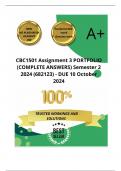,CBC1501 Assignment 3 PORTFOLIO (COMPLETE
ANSWERS) Semester 2 2024 - DUE 10 October 2024; 100%
TRUSTED Complete, trusted solutions and explanations.
MAIN SCENARIO Read the following scenario before
answering questions 2–4: Dr Shadi Hashimi has been appointed
as a senior researcher in the Department of Communication
Science at the University of South Africa (Unisa). His research
focuses on ethical communications in the era of the fifth
industrial revolution (5IR). Some of his research interests delve
into the issues of the digital footprint, digital literacy, verbal and
non-verbal communication and virtual teams. Some of his
preliminary research findings have identified key areas of
concern regarding the readiness of the South African youth for
the 5IR. The concerns that he has listed appear below: 1. The
South African youth lack basic digital literacy skills 2. Although
many youth have access to digital devices, they use these
devices for entertainment purposes and not for educational
purposes. 3. Netiquette in many areas of virtual collaboration is
ignored. 4. There is poor intercultural, multicultural and cross-
cultural awareness when interacting in virtual teams. 5. The
youth do not understand the importance of effective verbal and
non-verbal communication when interacting with others in a
virtual space. Dr Shadi Hashimi is thus concerned about these
issues and wants to address these concerns with key
stakeholders in the country. He is finalising his research findings
to share on various platforms. Firstly, he aims to distribute his
research findings through academic publications, public
participation forums, research reports, mass media and social
, media platforms, as well as through oral presentations in
different contexts. To do this, he has to identify the target
audience, the goal and the purpose of his communication for
each type of communication he plans to disseminate. Page 8 of
15 4.
Based on Dr. Shadi Hashimi’s research and communication
goals, here’s how he might approach disseminating his findings
through different communication platforms, considering the
target audience, goal, and purpose for each type:
1. Academic Publications
• Target Audience: Academics, researchers, and students in
the fields of communication science, digital literacy, and
education.
• Goal: To contribute to academic knowledge, spark further
research, and establish authority in the field of 5IR
communications.
• Purpose: To provide detailed and evidence-based research
findings that can be peer-reviewed and referenced in future
academic work.
2. Public Participation Forums
• Target Audience: General public, policymakers,
educators, and parents.
• Goal: To raise awareness about the digital literacy
challenges faced by South African youth and the broader
societal implications of 5IR.




